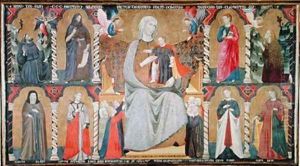da Rimini Giuliano Paintings
Giuliano da Rimini was an Italian painter, active during the Gothic period, who is best known for his work in the Marche and Romagna regions of Italy. Born around 1370, Giuliano's exact birthplace is not documented, but his surname suggests a connection to the town of Rimini, located on the Adriatic coast. Little is known about his early life and training, but it is believed that he was influenced by the Riminese school of painting, which was characterized by a blend of Byzantine and Gothic elements.
Giuliano's career spanned the late 14th and early 15th centuries, a time during which the Gothic style was prevalent in European art. He was a contemporary of other notable Italian painters such as Gentile da Fabriano and Lorenzo Monaco. Giuliano's work is often noted for its delicate linearity, elegant figures, and the use of rich colors. His paintings typically feature religious subjects, as was common during the period, with an emphasis on narrative and devotional imagery.
One of Giuliano da Rimini's most significant works is the 'Madonna and Child Enthroned', which showcases his ability to blend the spiritual solemnity of Byzantine icons with the more naturalistic approach of the Gothic tradition. The altarpiece demonstrates his skill in using gold leaf to create elaborate halos and intricate backgrounds that reflect the light and create a sense of the divine.
Despite his contributions to the Italian Gothic tradition, Giuliano da Rimini remains a relatively obscure figure in art history, with few documented works attributed to him. His death is believed to have occurred around 1444, by which time the Renaissance was beginning to take hold in Italy and transform the artistic landscape. Nevertheless, Giuliano's paintings are valuable for their representation of the transitional period between the medieval era and the Renaissance, and they provide insight into the regional variations of Italian Gothic art.
